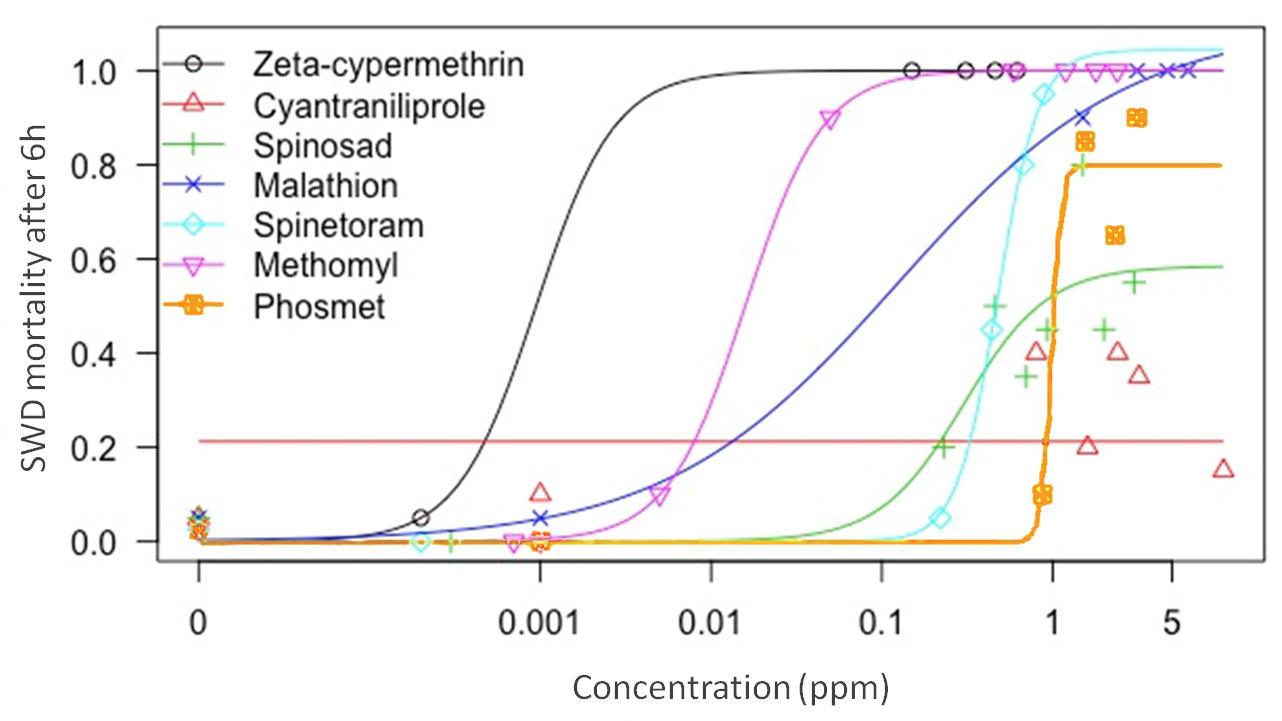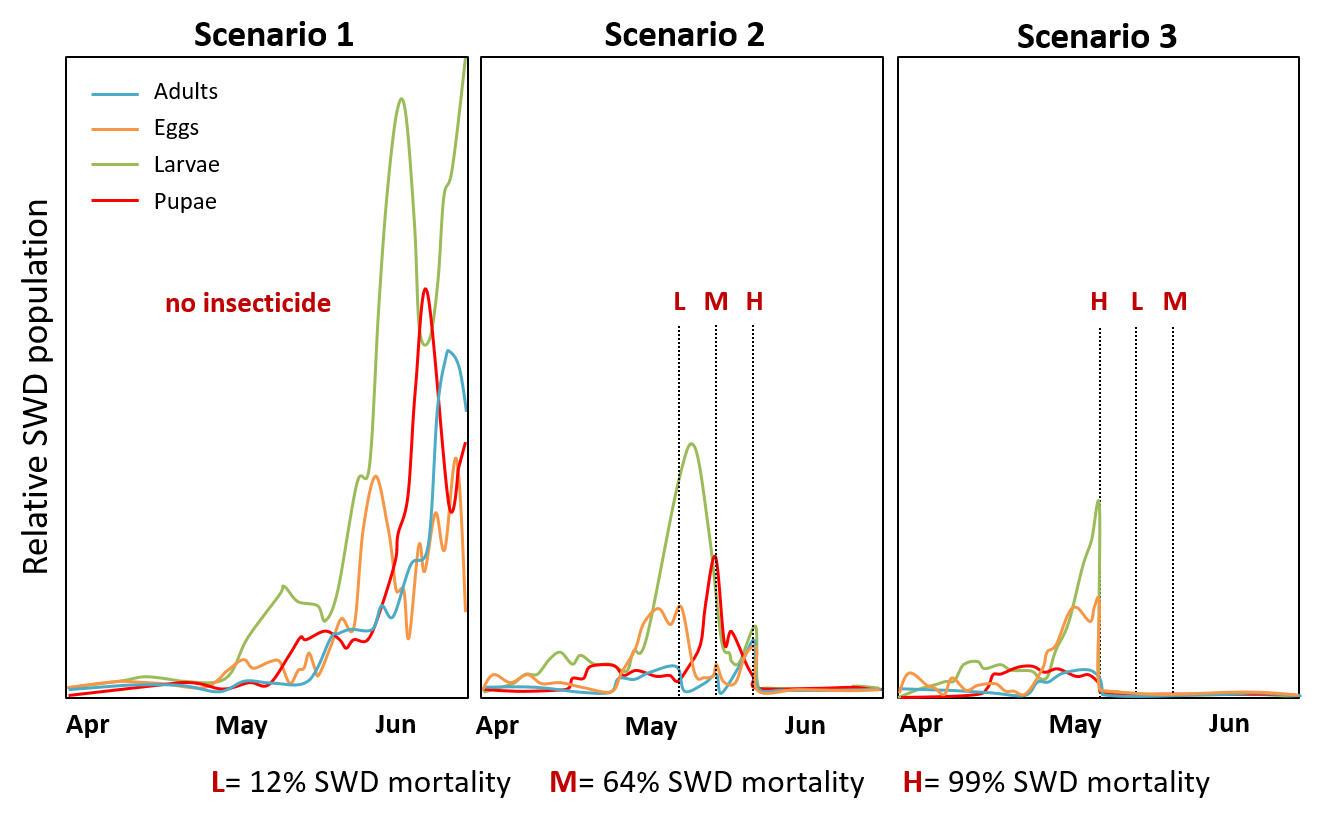SWD series #6
Key points from this fact sheet
- During the growing season, only 10% to 15% of the total spotted-wing drosophila (SWD) population is in the adult life stage.
- Most insecticides are effective in the field for a maximum of 10 days. Rain or overhead irrigation significantly reduce this time.
- Early in the growing season, insecticides can be applied less often, with up to 14 days between applications.
- Spray intervals should be shortened for late-ripening crops, when environmental conditions speed the SWD life cycle.
- Always rotate chemical classes of insecticides to limit the risk of insecticide resistance development.
- Follow all label instructions and pay special attention to preharvest interval (PHI), re-entry interval (REI) and maximum residue limit (MRL).
Factors that influence control
Several factors should be considered when selecting a management strategy against spotted-wing drosophila. The level of control achieved will depend on:
- The population structure (percent of each life stage) of the SWD population.
- The product effectiveness.
- The timeliness of insecticide application.
- The coverage of the fruit with the insecticide.
The population structure of SWD varies throughout the year. During winter and early spring, all SWD are believed to be adults. As the population begins to build and adults begin laying eggs, the relative proportion of adults decreases and larger portions of the total population are immature life stages: eggs, larvae and pupae. Adult SWD are believed to make up 5%–15% of the SWD population during the growing season. Adult flies are more susceptible to contact pesticides than any other SWD life stage.
Several insecticides provide adequate control of SWD, but most insecticides are effective in the field for 10 days or less. Rain or overhead irrigation wash off chemicals and limit insecticide longevity. When establishing new plots, consider installing drip irrigation. Many Oregon growers allow up to 14 days between insecticide applications in the early spring, but shorten the interval between sprays to protect late-ripening crops. As the spray interval is shortened, consider the seasonal limits for each product and the minimum time between sprays.
Insecticide efficacy varies based on SWD life stages. Malathion-based insecticide applications provide good adult control but are limited in controlling immature life stages. Spinetoram-based insecticide applications will kill up to 95% of adults and pupae, but affect a lower percentage of eggs and larvae. Methomyl-based insecticides will kill more than 95% of all life stages.
Mathematical models can help to optimize insecticide application scheduling (Figure 1). Several model simulations have shown that initial applications of insecticides that are more effective in killing all SWD life stages will provide better and longer pest control than initial applications of low efficacy pesticides.
When high SWD populations exert greater pressure on the crop, consider the knockdown potentials of different insecticides against SWD adults (Figure 2).
When the same insecticide class is applied repeatedly during the growing season, there is an increased chance of developing insecticide resistance and the loss of those chemistries for SWD management. Rotating insecticide classes throughout the growing season will minimize risk of insecticide resistance development. Every product has an Insecticide Resistance Action Committee (https://www.irac-online.org/) code on its label, indicating its pesticide class. Design your spray program to rotate among the products and classes labeled for your pest and crop. This principle is fundamental to delaying the onset of insecticide resistance.
Apply insecticides at the specified labeled rate. Consider the preharvest interval (PHI), re-entry interval (REI) and maximum residue limit (MRL) when planning any insecticide spray program.
Further reading
Diepenbrock, L.M., H.J. Burrack. 2016. Variation of within-crop microhabitat use by Drosophila suzukii (Diptera: Drosophilidae) in blackberry. Journal of Applied Entomology 141: 1–7.
Klick, J., W.Q. Yang, J.C. Lee, D.J. Bruck. 2016. Reduced spray programs for Drosophila suzukii management in berry crops. International Journal of Pest Management 62(4): 368-377.
Mermer, S., F. Pfab, G.A. Hoheisel, H.Y. Bahlol, L. Khot, D.T. Dalton, L.J. Brewer, M.V. Rossi-Stacconi, C. Zhang, L. Xue, V.M. Walton. Canopy spray deposition and related mortality impacts of commonly used insecticides on Drosophila suzukii Matsumura (Diptera: Drosophilidae) populations in blueberry. Pest Management Science. https://doi.org/10.1002/ps.5672.
Rendon, D., V.M. Walton. 2019. Drip and overhead sprinkler irrigation in blueberry as cultural control for Drosophila suzukii (Diptera: Drosophilidae) in Northwestern United States. Journal of Economic Entomology 112(2):745–752.
Rossi-Stacconi, M.V., R. Kaur, V. Mazzoni, L. Ometto, A. Grassi, A. Gottardello, O. Rota-Stabelli, G. Anfora. 2016. Multiple lines of evidence for reproductive winter diapause in the invasive pest Drosophila suzukii: useful clues for control strategies. Journal of Pest Science 89:689–700.
Wiman, N.G., V.M. Walton, D.T. Dalton, G. Anfora, H.J. Burrack, J.C. Chiu, K.M. Daane, A. Grassi, B. Miller, S. Tochen, X. Wang, C. Ioriatti. 2014. Integrating temperature-dependent life table data into a matrix projection model for Drosophila suzukii population estimation. PLoS One 9(9):e106909.
About this series
This publication is one of a series of nine publications focused on strategies for controlling spotted-wing drosophila in Oregon. Find them at https://catalog.extension.oregonstate.edu/. The publications in this series include:
- EM 9261: How Seasons Affect Population Structure, Behavior and Risk on Spotted-wing Drosophila
- EM 9262: Cultural Control Strategies to Manage Spotted-wing Drosophila
- EM 9263: Host Range and Characteristics Affecting Fruit Susceptibility to Spotted-wing Drosophila
- EM 9264 Noncrop Host Plants Used By Spotted-wing Drosophila
- EM 9265: Chemical Control of Spotted-wing Drosophila: Spray Applications
- EM 9266: Chemical Control of Spotted-wing Drosophila: Insecticide Efficacy
- EM 9267: Monitoring Techniques for Spotted-wing Drosophila
- EM 9268: Potential Impacts of Irrigation on Biocontrol on Spotted-wing Drosophila Populations
- EM 9269: Biocontrol of Spotted-wing Drosophila
© 2019 Oregon State University.




